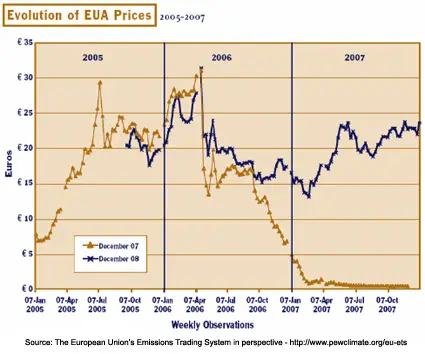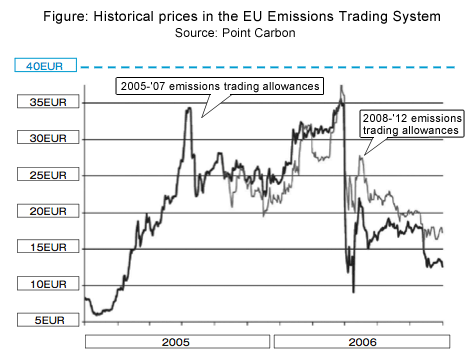Eu emissions trading system prices
The EU Emissions Trading System ETS for carbon dioxide CO2 is the largest worldwide. Since its inception init has experienced allowance price volatility and low overall prices. Generally, the fact that it costs less than anticipated to reduce CO2 emissions would be good news. Instead, these price dynamics are bad news for many because they suggest the program may fail to spark a significant transformation of the economy away from fossil fuel use.
To bolster allowance prices, EU authorities are taking steps to introduce a market stability reserve MSR. The MSR regulates the volume of allowances issued at any point in time depending on the volume in circulation and not yet used for compliance. Importantly, the MSR varies when allowances are issued but it does not vary the total number.
Read on below for highlights of key points:. What have we learned? The news, in my view, is mixed. Theory and some evidence suggest that, so far, the MSR will have a limited effect in fixing the problem directly.
EU Emissions Trading System Archive - Carbon Market Watch
However, to the credit of EU regulators, the MSR signals that the doctor has not given up on the patient. The European Union has a long-term commitment to emissions trading—the MSR may buy enough time for prices in the ETS to recover as the economy recovers.
If that does not happen, I believe the European Union may ultimately replace the MSR with a more direct and simpler instrument—a reserve price in auctions for emissions allowances that will instill a minimum price in the market.
European Union Emission Trading Scheme - Wikipedia
The EU has identified ambitious climate goals in the long run. However, the allowance prices today are a concern because they do not appear sufficient to trigger the innovation and investment that will be necessary to achieve the long run goals.
It is important to understand the cause of the problem in order to design an effective remedy. But, there does not appear to be a single explanation for the low demand for emissions allowances and the resulting low allowance prices. One cause might be the economic slowdown in Europe, which has reduced the demand for emissions allowances.
Another is overlapping policies by EU member states to promote renewable energy and energy efficiency, which also reduces the demand for emissions allowances. One group of authors has argued that low prices result because the current supply of allowances exceeds the demand of the electricity industry to hedge emissions associated with existing power contracts going out three to four years.
When the demand of the electricity sector is satisfied, allowance prices fall. In this view, moderating the short-run availability of allowances by adjusting their flow through the MSR will affect the near-term price without having to change the volume of allowances that are issued in the long run, a point that has been criticized by others.
In one of the new RFF papers mentioned above, RFF Visiting Fellow Steve Salant explores whether the limited demand to hedge power contracts explains low allowance prices and the observed jumps in those prices. In the current market environment, investors outside the electricity sector should be buying low to be able to sell high in the long term, when allowances are expected to be scarce. Such behavior would drive up short-term prices—but this has not occurred.

Salant suggests one reason may be that investors are uncertain about the survival of the program in the long run and hence require a premium to compensate for that risk. Paradoxically, however, the MSR may reinforce uncertainty to the degree that it signals that market outcomes aktualne kursy walut forex nawigator depend on additional future administrative action.
In another of the new RFF papersHarrison Fell of the Colorado School of Mines uses simulation modeling to illustrate how arbitrage across time relates prices in the present to prices in the future.
One would expect economic agents to adjust the timing of buying and selling allowances based on the path of prices over time—and, in turn, prices to adjust to that behavior. Fell finds that the MSR can reduce price volatility—but that its performance is especially sensitive to underlying economic parameters. Charles Holt and William Shobe, of the University eu emissions trading system prices Virginia, round out our how to get money on zynga poker. They examine market behavior in an experimental settingfinding that subjects in the laboratory do a good job of arbitraging across time periods.

And so compared to a policy of doing nothing, they find little benefit and possible cost associated with adjusting the quantity of allowances based on privately held inventories of unused allowances, such as would be the case with the MSR.
The analyses indicate that if the reason for low allowance prices has to do with satiation of demand to hedge power contracts and if other investors require a premium, the MSR may be effective in bolstering prices in the near term.
But if other factors contribute in an important way to interact with the program and depress prices, different remedies may be necessary. Whatever the cause, the low price of allowances is perceived as a negative feature of the EU ETS. All three North American programs—in California, Assault rifle stock for ruger 10/22, and the Regional Greenhouse Gas Initiative RGGI in the Northeast United States—include this feature.
The design looks just like the minimum acceptable bid option that one finds on eBay. Bids for emissions allowances below the reserve price in an auction are not filled. If sufficient demand does not exist above the reserve price, some allowances are not sold, restricting supply and helping to stabilize the price. These allowances may be available in a subsequent auction but ultimately should be withdrawn.
For example, in RGGI, the backlog of unsold allowances was permanently retired. In each North American program, the reserve price has been binding for at least one auction—and in every instance, the price has subsequently moved off the implied price floor.
And so these market-based programs have continued to function. For the EU ETS today, an auction reserve price was only briefly considered to remedy the issue of low allowance prices. Instead, policymakers in the European Union have opted to introduce the MSR—a somewhat complicated rule to modify the timing for introducing emissions allowances into circulation. It will be interesting to see if this approach achieves its desired effect.

Meanwhile, the option of a reserve price is an idea that may still gain appeal for its simplicity. Its time may yet come. Utility Nav Get Updates Support RFF Contact Search. About About RFF Careers News and Press RFF Centers and Programs Support RFF. Resources for the Future P St. NW, Suite Washington, DC Facebook Twitter LinkedIn Podcast. Blog Common Resources Blog. Recent Blog Posts Whither CO2? Seeking Science-Based Quantification of Carbon Cycle Uncertainty By Roger M.
CookeMichael Oppenheimer Do Consumers Benefit from Automobile Fuel Economy and Greenhouse Gas Standards? Events Upcoming Events Past Events Registration Live Stream. Events Past Event A Community Risk-Benefit Matrix of Unconventional Gas and Oil Development Past Event An Emissions Containment Reserve ECR for RGGI: A Report on the Analytical Results Past Event The Future of Carbon Capture, Utilization, and Storage CCUS: People Leadership Researchers Staff Affiliated Researchers.
Newell President and CEO Lea Harvey Vice President for Development and Corporate Secretary Terri O'Brien Vice President for Finance and Administration Margaret A. Walls Interim Vice President for Research and Senior Fellow. A Community Risk-Benefit Matrix of Unconventional Gas and Oil Development By Alan J. KrupnickIsabel EcharteLaura Zachary, Daniel Raimi How Much Do Consumers Value Fuel Economy and Performance?
Evidence from Technology Adoption By Benjamin LeardJoshua LinnYichen Christy Zhou What Stands in the Way Becomes the Way: Sequencing in Climate Policy to Ratchet Up Stringency Over Time By Michael Pahle, Dallas BurtrawChristian Flachsland, Nina Kelsey, Eric Biber, Jonas Meckling, Ottmar Edenhofer, John Zysman.
Leadership Researchers Staff Affiliated Researchers. Upcoming Events Past Events Registration Live Stream. White Distinguished Visiting Fellowship John V. Krutilla Research Stipend Joseph L. Fisher Doctoral Dissertation Fellowships RFF Summer Research Internship Program Walter O.
Memorial Internship News and Press Media Highlights Press Releases RFF Centers and Programs RFF's Center for Energy and Climate Economics Support RFF Giving Areas The Molly K. Macauley Award for Research Innovation and Advanced Analytics for Policy Ways to Give.
Blog Post Low Allowance Prices in the EU Emissions Trading System: New Research on an Evolving Program Jun 25, Dallas Burtraw.
Facebook LinkedIn Twitter Email.
European Union Emission Trading Scheme - Wikipedia
Climate Change Energy and Electricity Environmental Economics Topics International Subtopics: Cap and Trade Electricity Markets and Regulation Europe About the Author Dallas Burtraw Darius Gaskins Senior Fellow Related Content Working Paper What Ails the European Union's Emissions Trading System?
Two Diagnoses Calling for Different Treatments Jun 25, Stephen W. Climate Change Environmental Economics Topics. Get Blog Updates Sign up for notifications of new blog posts. RFF Email Options RFF Connection monthly Event invitations and notices Resources magazine three times per year RFF on the Issues weekly RFF's blog, Common Resources Press releases and media notes Opportunities to support RFF.
Search our Site Search. Contact Resources for the Future P St. NW, Suite Washington, DC Phone: Footer Links Privacy Policy Terms and Conditions of Use Feedback.